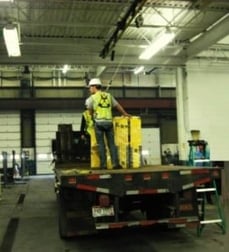Rigid Track Fall Arrest Systems for Low Fall Clearance Applications
Indoor, low fall clearance applications present unique engineering challenges. When our team of safety specialists conducts an indoor fall hazard assessment, much attention is paid to roof structure. The roof structure of a facility is important because it is a potential source of anchorage for a fall protection system. For low fall clearance applications, higher anchor points translate to larger and wider safe working areas. That said, the presence of overhead gas, water, and air pipes, conduit, and HVAC ductwork often interferes with the installation of fall arrest equipment.
Rigid track systems are ideal for applications with low fall clearances because they minimize deflection. That said, rigid track installations in plant areas congested with suspended MEP (Mechanical, Electrical, and Plumbing Systems) can challenge even the savviest fall protection engineer. There are plenty of pre-engineered rigid rail fall protection systems on the market, but virtually all of the available options feature a single piece, non-modular design. In case you are curious why this can present problems, the answer is simple—overhead fixed pipes and conduit can get in the way.
To illustrate, let’s assume the installation of a rigid track fall arrest system in a facility with a 20 foot ceiling. The intended installation area is obstructed by a four inch pipe dropped six inches below the structural roof steel and the rigid track system has an overall height of 18 inches. Because the competitor’s rigid rail system is not modular, the installer has no recourse other than dropping the entire system below the pipe. In this scenario, the anchor point is 28 inches closer to the ground to avoid the fixed pipe.
 A loss of 28 inches may not seem that important to the casual observer, but what happens when the workers using the system are standing on top of a flatbed trailer? The reduction in anchorage height of 28 inches reduces the safe diameter, or “cone of safety” by 14 inches in any direction from the anchor point. This reduction can easily make it so your worker, although tied off, cannot access the entire flatbed without subjecting them selves to a swing fall. Most flatbed trailers are 52 inches high, and a fall from this height can have catastrophic or even deadly consequences. Therefore, flatbed trailers present an unprotected leading edge of 4 feet or more, so OSHA regulations require the use of fall protection when employees are loading and unloading cargo. The challenges here are twofold: (i) complying with OSHA’s 4 foot safety margin and more importantly, (ii) arresting the fall BEFORE a worker strikes the ground. With these facts in mind, the 28 inches lost while installing the fall arrest system becomes a huge problem.
A loss of 28 inches may not seem that important to the casual observer, but what happens when the workers using the system are standing on top of a flatbed trailer? The reduction in anchorage height of 28 inches reduces the safe diameter, or “cone of safety” by 14 inches in any direction from the anchor point. This reduction can easily make it so your worker, although tied off, cannot access the entire flatbed without subjecting them selves to a swing fall. Most flatbed trailers are 52 inches high, and a fall from this height can have catastrophic or even deadly consequences. Therefore, flatbed trailers present an unprotected leading edge of 4 feet or more, so OSHA regulations require the use of fall protection when employees are loading and unloading cargo. The challenges here are twofold: (i) complying with OSHA’s 4 foot safety margin and more importantly, (ii) arresting the fall BEFORE a worker strikes the ground. With these facts in mind, the 28 inches lost while installing the fall arrest system becomes a huge problem.
Engineers at Diversified Fall Protection recognized the above scenario outlined was a common problem, so they designed a new, modular track system that helps installers work around overhead obstructions. Unlike the fixed designs utilized by our competitors, our system is installed in modular sections. When obstructions are present, installers position the structural members above and below the trouble spot, and then secure them in place. Put another way, instead of positioning the track system below the obstructing pipe, the pipe can run between the top and bottom sections of the system. There is no need to move the obstruction or the designated installation area, and best of all, there is no loss in anchor point height. Remember, positioning the fall arrest system as high as possible widens the safe working area. As a rule of thumb, for every ten feet the anchor is positioned above the work area, we create a 12-foot diameter safe working zone.
Our modular, rigid track fall arrest system may be new, but its design concept is already garnering attention from safety specialists. Last month, our new modular track design was recognized by the Ohio Bureau of Workman’s Compensation for its contribution to improved worker safety.
The presence of existing overhead mechanical, electrical, and plumbing systems routed through the intended work area often complicates installation of indoor fall arrest systems. By partnering with a fall protection company that has both the experience and the appropriate right fall arrest systems for your application, you can ensure OSHA compliance and a safe work environment for your employees. If you are interested in learning more about our modular rigid rail fall arrest systems for indoor applications, contact Diversified Fall Protection for further assistance
Schedule an assessment with Diversified Fall Protection
Contact Us to request a fall safety review

b-1.jpg?width=1368&height=1340&name=Rail%20(175)b-1.jpg)

